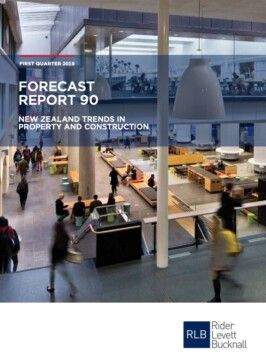The Rider Levett Bucknall (RLB) Forecast 90 report – New Zealand Trends in Property and Construction – released today confirms non-residential construction demand remains high in Auckland and Wellington, while picking up in Waikato.
Prepared by the New Zealand Institute of Economic Research (Inc.) (NZIER) exclusively for RLB, Forecast 90 shows stronger demand for retail outlets and industrial buildings is supporting Auckland non-residential construction demand.
Grant Watkins, Director of RLB Wellington said, ‘Underlying demand for construction is robust. Demand in Auckland is strong across both residential and nonresidential, reflecting the effects of the surge in the region’s population over the past few years.’
Demand increasing for social and retail buildings in Canterbury
Construction in Canterbury is stabilising after declining since 2016. Over the past year, increased demand for social buildings and retail outlets is offsetting reduced office building construction. Nonetheless, construction activity in the Canterbury region remains relatively high.’
Grant continued, ‘Wellington is very busy in all sectors at present and resources are very tight with no end in sight at present.’
Slowing migration eases population growth, but work visas increasing
According to RLB, a further slowing in net migration is driving easing population growth in New Zealand, with annual net inflows edging below 62,000 for the first time since September 2015. Improving job prospects across the Tasman is supporting further net outflows to Australia.
While there is a reduced number of people coming in on residency and student visas, the number of people moving to New Zealand on work visas continues to lift, helping to alleviate labour shortages in the construction sector over 2018.
Grant added, ‘We expect the government will continue to focus on bringing in more trades workers over the coming year given the substantial amount of construction activity still to take place to meet housing demand.’
Construction picking up in 2019 as banks tightening access to credit
After plateauing in early 2018, the pipeline of residential and commercial construction is growing. The flattening off in activity earlier in 2018 reflected uncertainty about the feasibility of some developments considering financing constraints.
Banks have tightened up on access to credit, and increased capital requirements for banks mean there is likely to be further tightening over the coming years.
According to RLB, there continues to be a shift towards intensification of housing, with growth in consent issuance concentrated in multi-unit dwellings such as apartments and townhouses. This trend should continue over the coming years, although low operating margins, labour shortages and uncertainty of cashflow faced by construction sector firms present headwinds to large-scale developments.
New retail and social buildings top drivers of growth
Demand for these sectors of non-residential construction was particularly strong in Auckland. However, Auckland also drove a sharp drop in demand for new office buildings, albeit from high levels in the previous year.
Grant concluded, ‘There was also an increase in demand for industrial, farm and storage buildings, reflecting improving demand in Waikato. Increasing confidence about profitability in the rural sector is underpinning this increased demand.’
FURTHER INFORMATION:



